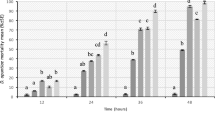Abstract
A high level of resistance to chlorpyrifos has been detected in Culex quinquefasciatus larvae from Dar es Salaam. To study the impact of this resistance on the routine anti-larval spraying programme with this chemical, pit latrines, cess pits and soakage pits were examined regularly after spraying. Larvae were eliminated immediately after spraying, but in most cases they re-appeared about 2 weeks later. Bio-assays with susceptible and resistant larvae in water samples from the pits showed that in most cases there would have been sufficient insecticide residue for at least 10 weeks to kill a susceptible population, but resistant larvae could survive in the water from about 2 weeks after spraying. Chemical analysis showed that the water was toxic to resistant larvae so long as it contained about 0.02 mg/1 chlorpyrifos. These observations might have suggested that the routine spraying programme every 10 weeks would be having very little impact on the population now that resistance has evolved. However, in fact, adult densities in houses in a year with spraying on schedule were much less than in years when many sprayings were missed owing to shortage of supplies. Thus the regular spraying programme still apppears to have a beneficial effect.
Similar content being viewed by others
References
Bang Y. H., Sabuni I. B. and Tonn R. T. (1975) Integrated control of urban mosquitoes in Dar es Salaam using community sanitation supplemented by larviciding. E. Afr. med. J. 52, 578–588.
Curtis C. F. (1980) Insect traps for pit latrines. Mosq. News 40, 626–628.
Curtis C. F. and Pasteur N. (1981) Organophosphate resistance in vector populations of the complex of Culex pipiens L. Bull. ent. Res. 71, 153–161.
Curtis C. F. and Suya T. B. (1981) Variations in cytoplasmic incompatibility properties in Tanzanian populations of Culex quinquefasciatus. Ann. trop. Med. Parasit. 75, 101–106.
Reiter P. (1978) Expanded polystyrene balls: an idea for mosquito control. Ann. trop. Med. Parasit. 72, 595–596.
Schaefer C. H. and Dupras E. F. (1970) Factors affecting the stability of Dursban in polluted waters. J. econ. Ent. 63, 701–705.
Sinègre G., Jullien J. L. and Gaven B. (1977) Acquisition progressive de la résistance au chlorpyrifos chez les larves de Culex pipiens dans le midi de la France. Parassitologia 19, 79–94.
Villani F., White G. B., Curtis C. F. and Miles S. J. (1983) Inheritance and activity of some esterases associated with organophosphate resistance in mosquitoes of the complex of Culex pipiens L. Bull. ent. Res. 73, 153–166.
Author information
Authors and Affiliations
Rights and permissions
About this article
Cite this article
Curtis, C.F., Keto, A., Ramji, B.D. et al. Assessment of the Impact of Chlorpyrifos Resistance in Culex Quinquefasciatus on a Control Scheme. Int J Trop Insect Sci 5, 263–267 (1984). https://doi.org/10.1017/S1742758400001545
Received:
Published:
Issue Date:
DOI: https://doi.org/10.1017/S1742758400001545



